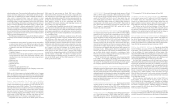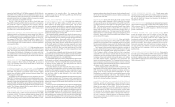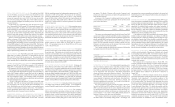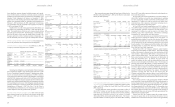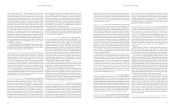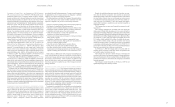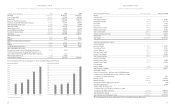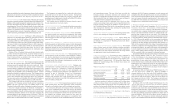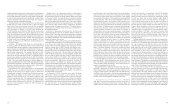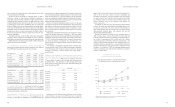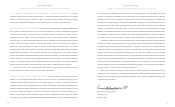Abercrombie & Fitch 2006 Annual Report Download - page 18
Download and view the complete annual report
Please find page 18 of the 2006 Abercrombie & Fitch annual report below. You can navigate through the pages in the report by either clicking on the pages listed below, or by using the keyword search tool below to find specific information within the annual report.
Abercrombie &Fitch
35
Common Stock to the majority of associates who are subject to Section
16 of the Securities Exchange Act of 1934, as amended, and any non-
associate directors of the Company. The 2002 Plan, which is not a
shareholder approved plan, permits the Company to grant up to 7.0
million shares of A&F’s Common Stock to any associate. Under both
plans, stock options and restricted stock units vest primarily over four
years for associates. Under the 2005 LTIP, stock options and restricted
stock units vest over one year for non-associate directors. Stock options
have a ten year contractual term and the plans provide for accelerated
vesting if there is a change of control as defined in the plans.
The Company issues shares for stock option exercises and restrict-
ed stock unit vestings from treasury stock. As of February 3, 2007, the
Company had enough treasury stock available to cover stock options
and restricted stock units outstanding without having to repurchase
additional stock.
FAIR VALUE ESTIMATES The Company estimates the fair value
of stock options granted using the Black-Scholes option-pricing
model, which requires the Company to estimate the expected term of
the stock option grants and expected future stock price volatility over
the term. The term represents the expected period of time the
Company believes the options will be outstanding based on historical
experience. Estimates of expected future stock price volatility are
based on the historic volatility of the Company’s stock for the period
equal to the expected term of the stock option. The Company calcu-
lates the volatility as the annualized standard deviation of the differ-
ences in the natural logarithms of the weekly stock closing price,
adjusted for stock splits.
The weighted-average estimated fair values of stock options granted
during the fifty-three week period ended February 3, 2007 and the
fifty-two week periods ended January 28, 2006 and January 29, 2005,
as well as the weighted-average assumptions used in calculating such
values, on the date of grant, were as follows:
Fifty-Three Fifty-Two Fifty-Two
Weeks Ended Weeks Ended Weeks Ended
February 3, 2007 January 28, 2006 January 29, 2005
Executive Executive
Executive Other Officers and Officers and
Officers Associates Other Associates Other Associates
Exercise price $58.22 $58.12 $60.10 $36.49
Fair Value $24.92 $20.69 $23.01 $14.56
Assumptions:
Price volatility 47% 42% 47% 56%
Expected term (Years) 5 4 4 4
Risk-free interest rate 4.9% 4.9% 4.0% 3.2%
Dividend yield 1.2% 1.2% 1.1% 1.3%
In the case of restricted stock units, the Company calculates the fair
value of the restricted stock units granted as the market price of the
underlying Common Stock on the date of issuance adjusted for antic-
ipated dividend payments during the vesting period.
STOCK OPTION ACTIVITY Below is the summary of stock option
activity for Fiscal 2006:
Fifty-Three Weeks Ended February 3, 2007
Number Weighted- Aggregate Weighted-Average
Stock of Average Intrinsic Remaining
Options Shares Exercise Price Value Contractual Life
Outstanding at
January 29, 2006 9,060,831 $37.18
Granted 411,300 58.16
Exercised (440,457) 31.74
Forfeited or expired (226,950) 53.18
Outstanding at
February 3, 2007 8,804,724 $38.07 $375,970,520 3.7
Options expected to
vest at February 3, 2007 625,242 $54.92 $ 16,162,506 8.4
Options exercisable
at February 3, 2007 8,136,922 $36.67 $358,856,161 3.4
The total intrinsic value of stock options exercised during the fifty-three
weeks ended February 3, 2007 and the fifty-two weeks ended January
28, 2006 and January 29, 2005 was $15.2 million, $139.9 million and
$46.8 million, respectively.
The total fair value of stock options vested during the fifty-three
weeks ended February 3, 2007 and the fifty-two weeks ended January
28, 2006 and January 29, 2005 was $29.5 million, $31.4 million and
$31.0 million, respectively.
As of February 3, 2007, there was $11.0 million of total unrecog-
nized compensation cost, net of estimated forfeitures, related to stock
options. The unrecognized cost is expected to be recognized over a
weighted-average period of 1.4 years.
RESTRICTED STOCK UNIT ACTIVITY A summary of the sta-
tus of the Company’s restricted stock units as of February 3, 2007 and
changes during the fifty-three week period ended February 3, 2007
were as follows:
Weighted-Average
Restricted Number of Grant Date
Stock Units Shares Fair Value
Non-vested at January 29, 2006 1,856,847 $36.54
Granted 603,882 $58.73
Vested (204,430) $42.08
Forfeited (212,843) $54.67
Non-vested at February 3, 2007 2,043,456 $40.65
The total fair value of restricted stock units granted during the
fifty-three weeks ended February 3, 2007 and fifty-two weeks ended
January 28, 2006 and January 29, 2005 was $35.5 million, $36.3 mil-
lion and $16.0 million, respectively.
The total fair value of restricted stock units vested during the fifty-
three weeks ended February 3, 2007 and fifty-two weeks ended
January 28, 2006 and January 29, 2005 was $8.6 million, $5.0 million
and $1.0 million, respectively.
As of February 3, 2007, there was $46.4 million of total unrecog-
Abercrombie &Fitch
34
4. SHARE-BASED COMPENSATION
BACKGROUND
On January 29, 2006, the Company adopted SFAS
No. 123 (Revised 2004), “Share-Based Payment” (“SFAS No. 123(R)”),
which requires share-based compensation to be measured based on
estimated fair values at the date of grant using an option-pricing model.
Previously, the Company accounted for share-based compensation
using the intrinsic value method in accordance with APB Opinion No.
25, “Accounting for Stock Issued to Employees,” and related interpretations,
for which no expense was recognized for stock options if the exercise
price was equal to the market value of the underlying common stock on
the date of grant, and if the Company provided the required pro forma
disclosures in accordance with SFAS No. 123, “Accounting for Stock-
Based Compensation” (“SFAS No. 123”), as amended.
The Company adopted SFAS No. 123(R) using the modified
prospective transition method, which requires share-based compensa-
tion to be recognized for all unvested share-based awards beginning in
the first quarter of adoption. Accordingly, prior period information pre-
sented in these financial statements has not been restated to reflect the
fair value method of expensing stock options. Under the modified
prospective method, compensation expense recognized for the fifty-three
weeks ended February 3, 2007 includes compensation expense for: a) all
share-based awards granted prior to, but not yet vested as of, January 29,
2006, based on the grant-date fair value estimated in accordance with the
original provisions of SFAS No. 123 and b) all share-based awards grant-
ed subsequent to January 29, 2006, based on the grant-date fair value
estimated in accordance with the provisions of SFAS No. 123(R).
FINANCIAL STATEMENT IMPACT Total share-based compen-
sation expense recognized under SFAS No. 123(R) was $35.1 million
for the fifty-three week period ended February 3, 2007. Share-based
compensation expense of $24.1 million and $10.4 million was recognized
for the fifty-two week periods ended January 28, 2006 and January 29,
2005, under APB 25.
The Company also realized $5.5 million, $52.7 million and $17.3
million in cash tax benefits for the fifty-three week period ended
February 3, 2007 and the fifty-two week periods ended January 28, 2006
and January 29, 2005, respectively, related to stock option exercises
and restricted stock issuances.
The following table summarizes the incremental effect of the
adoption of SFAS No. 123(R) to the Company’s consolidated financial
statements for the fifty-three weeks ended February 3, 2007:
(Thousands, except per share amounts) Fifty-Three Weeks Ended
February 3, 2007
Stores and distribution expense $ 463
Marketing, general and administrative expense 13,627
Operating income 14,090
Provision for income taxes (4,210)
Net income $ 9,880
Net income per basic share $ 0.11
Net income per diluted share $ 0.11
Net cash used for operating activities $ (3,382)
Net cash provided by financing activities $ 3,382
The following table is presented for comparative purposes and illus-
trates the pro forma effect on net income and net income per share for
the fifty-two weeks ended January 28, 2006 and January 29, 2005, as if
the Company had applied the fair value recognition provisions of SFAS
No. 123 to stock options granted under the Company’s share-based
compensation plans prior to January 29, 2006:
(Thousands, except per share amounts) Fifty-Two Fifty-Two
Weeks Ended Weeks Ended
January 28, 2006 January 29, 2005
Net income:
As reported $333,986 $216,376
Share-based compensation expense included
in reported net income, net of tax
(1)
14,716 6,358
Share-based compensation expense determined
under fair value based method, net of tax (36,689) (27,720)
Pro forma $312,013 $195,014
Net income per basic share:
As reported $3.83 $2.33
Pro forma $3.58 $2.10
Net income per diluted share:
As reported $3.66 $2.28
Pro forma $3.38 $2.05
(1)
Includes share-based compensation expense related to restricted stock unit awards actually recognized
in net income in each period presented using the intrinsic value method.
Share-based compensation expense is recognized, net of estimated
forfeitures, over the requisite service period on a straight line basis. The
Company adjusts share-based compensation on a quarterly basis for
actual forfeitures and on a periodic basis for changes to the estimate of
expected forfeitures based on actual forfeiture experience. The effect of
adjusting the forfeiture rate is recognized in the period the forfeiture
estimate is changed. The effect of forfeiture adjustments during the
fifty-three week period ended February 3, 2007 was immaterial.
Upon adoption of SFAS No. 123(R), the Company began present-
ing the deferred compensation for share-based compensation in the
Condensed Consolidated Balance Sheet as part of paid-in capital and
the related tax benefit in paid-in capital. Additionally, the Company
began presenting the excess tax benefit in the Consolidated Statement
of Cash Flows as part of the financing activities. Prior to adoption of
SFAS No. 123(R), the deferred compensation was presented in the
Condensed Consolidated Balance Sheet as deferred compensation
and the related tax benefit was presented in the Condensed
Consolidated Statement of Cash Flows in operating activities.
PLANS As of February 3, 2007, the Company had two primary share-
based compensation plans, the 2002 Stock Plan for Associates (the
“2002 Plan”) and the 2005 Long-Term Incentive Plan (the “2005
LTIP”), under which it grants stock options and restricted stock units
to its associates and non-associate board members. The Company also
has three other share-based compensation plans under which it grant-
ed stock options and restricted stock units to its associates and non-
associate board members in prior years.
The 2005 LTIP, which is a shareholder approved plan, permits the
Company to grant up to approximately 2.0 million shares of A&F’s


